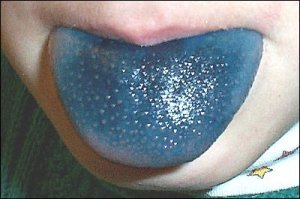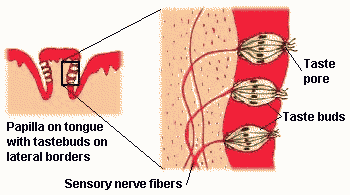Vivo Pathophysiology
Physiology of Taste
The sense of taste affords an animal the ability to evaluate what it eats and drinks. At the most basic level, this evaluation is to promote ingestion of nutritious substances and prevent consumption of potential poisons or toxins. There is no doubt that animals, including humans, develop taste preferences. That is, they will choose certain types of food in preference to others. Interestingly, taste preference often changes in conjunction with body needs. Similarly, animals often develop food aversions, particularly if they become ill soon after eating a certain food, even though that food was not the cause of the illness - surely you have experienced this yourself. Food preferences and aversions involve the sense of taste, but these phenomena are almost certainly mediated through the central nervous system.
Taste Receptor Cells, Taste Buds and Taste Nerves
The sense of taste is mediated by taste receptor cells which are bundled in clusters called taste buds. Taste receptor cells sample oral concentrations of a large number of small molecules and report a sensation of taste to centers in the brainstem.
In most animals, including humans, taste buds are most prevalent on small pegs of epithelium on the tongue called papillae. The taste buds themselves are too small to see without a microscope, but papillae are readily observed by close inspection of the tongue's surface. To make them even easier to see, put a couple of drops of blue food coloring on the tongue of a loved one, and you'll see a bunch of little pale bumps - mostly fungiform papillae - stand out on a blue background.

Taste buds are composed of groups of between 50 and 150 columnar taste receptor cells bundled together like a cluster of bananas. The taste receptor cells within a bud are arranged such that their tips form a small taste pore, and through this pore extend microvilli from the taste cells. The microvilli of the taste cells bear taste receptors.
Interwoven among the taste cells in a taste bud is a network of dendrites of sensory nerves called "taste nerves". When taste cells are stimulated by binding of chemicals to their receptors, they depolarize and this depolarization is transmitted to the taste nerve fibers resulting in an action potential that is ultimately transmitted to the brain. One interesting aspect of this nerve transmission is that it rapidly adapts - after the initial stimulus, a strong discharge is seen in the taste nerve fibers but within a few seconds, that response diminishes to a steady-state level of much lower amplitude.

Once taste signals are transmitted to the brain, several efferent neural pathways are activated that are important to digestive function. For example, tasting food is followed rapidly by increased salivation and by low level secretory activity in the stomach.
Among humans, there is substantial difference in taste sensitivity. Roughly one in four people is a "supertaster" that is several times more sensitive to bitter and other tastes than those that taste poorly. Such differences are heritable and reflect differences in the number of fungiform papillae and hence taste buds on the tongue.
In addition to signal transduction by taste receptor cells, it is also clear that the sense of smell profoundly affects the sensation of taste. Think about how tastes are blunted and sometimes different when your sense of smell is disrupted due to a cold.
Taste Sensations
The sense of taste is equivalent to excitation of taste receptors, and receptors for a large number of specific chemicals have been identified that contribute to the reception of taste. Despite this complexity, five types of tastes are commonly recognized by humans:
- Sweet - usually indicates energy rich nutrients
- Umami - the taste of amino acids (e.g. meat broth or aged cheese)
- Salty - allows modulating diet for electrolyte balance
- Sour - typically the taste of acids
- Bitter - allows sensing of diverse natural toxins
None of these tastes are elicited by a single chemical. Also, there are thresholds for detection of taste that differ among chemicals that taste the same. For example, sucrose, 1-propyl-2 amino-4-nitrobenzene and lactose all taste sweet to humans, but the sweet taste is elicited by these chemicals at concentrations of roughly 10 mM, 2 uM and 30 mM respectively - a range of potency of roughly 15,000-fold. Substances sensed as bitter typically have very low thresholds.
| Examples of some human thresholds | ||
|---|---|---|
| Taste | Substance | Threshold for tasting |
| Salty | NaCl | 0.01 M |
| Sour | HCl | 0.0009 M |
| Sweet | Sucrose | 0.01 M |
| Bitter | Quinine | 0.000008 M |
| Umami | Glutamate | 0.0007 M |
It should be noted that these tastes are based on human sensations and some comparative physiologists caution that each animal probably lives in its own "taste world". For animals, it may be more appropriate to discuss tastes as being pleasant, unpleasant or indifferent. Additionally, there are some clear differences among animals in what they can taste. Cats, for example, do not respond to sweets due to a deletion in the gene that encodes one of the sweet receptors.
Perception of taste also appears to be influenced by thermal stimulation of the tongue. In some people, warming the front of the tongue produces a clear sweet sensation, while cooling leads to a salty or sour sensation.
Taste Receptors
A very large number of molecules elicit taste sensations through a rather small number of taste receptors. Furthermore, it appears that individual taste receptor cells bear receptors for one type of taste. In other words, within a taste bud, some taste receptor cells sense sweet, while others have receptors for bitter, sour, salty and umami tastes. Much of this understanding of taste receptors has derived from behavioral studies with mice engineered to lack one or more taste receptors.
The pleasant tastes (sweet and umami) are mediated by a family of three T1R receptors that assemble in pairs. Diverse molecules that lead to a sensation of sweet bind to a receptor formed from T1R2 and T1R3 subunits. Cats have a deletion in the gene for T1R2, explaining their non-responsiveness to sweet tastes. Also, mice engineered to express the human T1R2 protein have a human-like response to different sweet tastes. The receptor formed as a complex of T1R1 and T1R3 binds L-glutamate and L-amino acids, resulting the umami taste.
The bitter taste results from binding of diverse molecules to a family of about 30 T2R receptors. Sour tasting itself involves activation of a type of TRP (transient receptor potential) channel. Surprisingly, the molecular mechanisms of salt taste reception are poorly characterized relative to the other tastes.
Send comments to Richard.Bowen@colostate.edu

